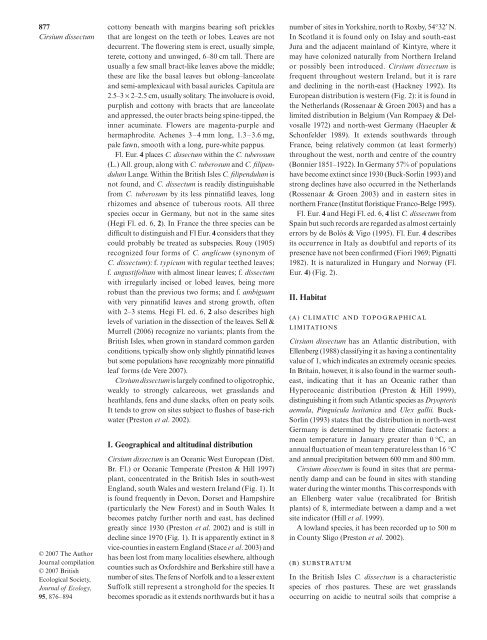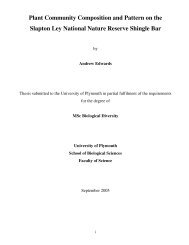de Vere 2007 Biol Flora C. dissectum.pdf - The Whitley Wildlife ...
de Vere 2007 Biol Flora C. dissectum.pdf - The Whitley Wildlife ...
de Vere 2007 Biol Flora C. dissectum.pdf - The Whitley Wildlife ...
- No tags were found...
You also want an ePaper? Increase the reach of your titles
YUMPU automatically turns print PDFs into web optimized ePapers that Google loves.
877Cirsium <strong>dissectum</strong>© <strong>2007</strong> <strong>The</strong> AuthorJournal compilation© <strong>2007</strong> BritishEcological Society,Journal of Ecology,95, 876–894cottony beneath with margins bearing soft pricklesthat are longest on the teeth or lobes. Leaves are not<strong>de</strong>current. <strong>The</strong> flowering stem is erect, usually simple,terete, cottony and unwinged, 6–80 cm tall. <strong>The</strong>re areusually a few small bract-like leaves above the middle;these are like the basal leaves but oblong–lanceolateand semi-amplexicaul with basal auricles. Capitula are2.5–3 × 2–2.5 cm, usually solitary. <strong>The</strong> involucre is ovoid,purplish and cottony with bracts that are lanceolateand appressed, the outer bracts being spine-tipped, theinner acuminate. Flowers are magenta-purple andhermaphrodite. Achenes 3–4 mm long, 1.3–3.6 mg,pale fawn, smooth with a long, pure-white pappus.Fl. Eur. 4 places C. <strong>dissectum</strong> within the C. tuberosum(L.) All. group, along with C. tuberosum and C. filipendulumLange. Within the British Isles C. filipendulum isnot found, and C. <strong>dissectum</strong> is readily distinguishablefrom C. tuberosum by its less pinnatifid leaves, longrhizomes and absence of tuberous roots. All threespecies occur in Germany, but not in the same sites(Hegi Fl. ed. 6, 2). In France the three species can bedifficult to distinguish and Fl Eur. 4 consi<strong>de</strong>rs that theycould probably be treated as subspecies. Rouy (1905)recognized four forms of C. anglicum (synonym ofC. <strong>dissectum</strong>): f. typicum with regular teethed leaves;f. angustifolium with almost linear leaves; f. <strong>dissectum</strong>with irregularly incised or lobed leaves, being morerobust than the previous two forms; and f. ambiguumwith very pinnatifid leaves and strong growth, oftenwith 2–3 stems. Hegi Fl. ed. 6, 2 also <strong>de</strong>scribes highlevels of variation in the dissection of the leaves. Sell &Murrell (2006) recognize no variants; plants from theBritish Isles, when grown in standard common gar<strong>de</strong>nconditions, typically show only slightly pinnatifid leavesbut some populations have recognizably more pinnatifidleaf forms (<strong>de</strong> <strong>Vere</strong> <strong>2007</strong>).Cirsium <strong>dissectum</strong> is largely confined to oligotrophic,weakly to strongly calcareous, wet grasslands andheathlands, fens and dune slacks, often on peaty soils.It tends to grow on sites subject to flushes of base-richwater (Preston et al. 2002).I. Geographical and altitudinal distributionCirsium <strong>dissectum</strong> is an Oceanic West European (Dist.Br. Fl.) or Oceanic Temperate (Preston & Hill 1997)plant, concentrated in the British Isles in south-westEngland, south Wales and western Ireland (Fig. 1). Itis found frequently in Devon, Dorset and Hampshire(particularly the New Forest) and in South Wales. Itbecomes patchy further north and east, has <strong>de</strong>clinedgreatly since 1930 (Preston et al. 2002) and is still in<strong>de</strong>cline since 1970 (Fig. 1). It is apparently extinct in 8vice-counties in eastern England (Stace et al. 2003) andhas been lost from many localities elsewhere, althoughcounties such as Oxfordshire and Berkshire still have anumber of sites. <strong>The</strong> fens of Norfolk and to a lesser extentSuffolk still represent a stronghold for the species. Itbecomes sporadic as it extends northwards but it has anumber of sites in Yorkshire, north to Roxby, 54°32′ N.In Scotland it is found only on Islay and south-eastJura and the adjacent mainland of Kintyre, where itmay have colonized naturally from Northern Irelandor possibly been introduced. Cirsium <strong>dissectum</strong> isfrequent throughout western Ireland, but it is rareand <strong>de</strong>clining in the north-east (Hackney 1992). ItsEuropean distribution is western (Fig. 2): it is found inthe Netherlands (Rossenaar & Groen 2003) and has alimited distribution in Belgium (Van Rompaey & Delvosalle1972) and north-west Germany (Haeupler &Schonfel<strong>de</strong>r 1989). It extends southwards throughFrance, being relatively common (at least formerly)throughout the west, north and centre of the country(Bonnier 1851–1922). In Germany 57% of populationshave become extinct since 1930 (Buck-Sorlin 1993) andstrong <strong>de</strong>clines have also occurred in the Netherlands(Rossenaar & Groen 2003) and in eastern sites innorthern France (Institut floristique Franco-Belge 1995).Fl. Eur. 4 and Hegi Fl. ed. 6, 4 list C. <strong>dissectum</strong> fromSpain but such records are regar<strong>de</strong>d as almost certainlyerrors by <strong>de</strong> Bolòs & Vigo (1995). Fl. Eur. 4 <strong>de</strong>scribesits occurrence in Italy as doubtful and reports of itspresence have not been confirmed (Fiori 1969; Pignatti1982). It is naturalized in Hungary and Norway (Fl.Eur. 4) (Fig. 2).II. Habitat(A) CLIMATIC AND TOPOGRAPHICALLIMITATIONSCirsium <strong>dissectum</strong> has an Atlantic distribution, withEllenberg (1988) classifying it as having a continentalityvalue of 1, which indicates an extremely oceanic species.In Britain, however, it is also found in the warmer southeast,indicating that it has an Oceanic rather thanHyperoceanic distribution (Preston & Hill 1999),distinguishing it from such Atlantic species as Dryopterisaemula, Pinguicula lusitanica and Ulex gallii. Buck-Sorlin (1993) states that the distribution in north-westGermany is <strong>de</strong>termined by three climatic factors: amean temperature in January greater than 0 °C, anannual fluctuation of mean temperature less than 16 °Cand annual precipitation between 600 mm and 800 mm.Cirsium <strong>dissectum</strong> is found in sites that are permanentlydamp and can be found in sites with standingwater during the winter months. This corresponds withan Ellenberg water value (recalibrated for Britishplants) of 8, intermediate between a damp and a wetsite indicator (Hill et al. 1999).A lowland species, it has been recor<strong>de</strong>d up to 500 min County Sligo (Preston et al. 2002).(B) SUBSTRATUMIn the British Isles C. <strong>dissectum</strong> is a characteristicspecies of rhos pastures. <strong>The</strong>se are wet grasslandsoccurring on acidic to neutral soils that comprise a




